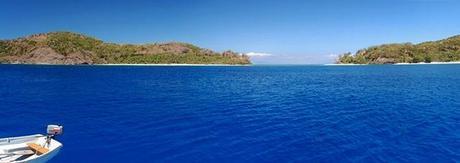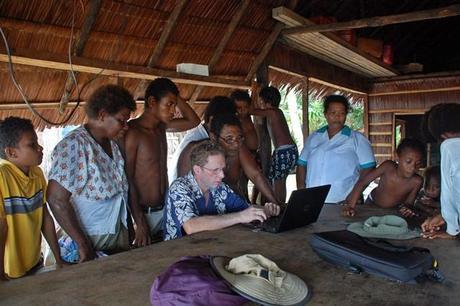
How do you get online as an active cruiser?
On one hand, the prospect of cruising means freedom from the always-on, always-connected world. Liberating, right? It can be. But if you’re like me, you might get kind of twitchy. I admit: the first year was hard. It was used to instant gratification for simple tasks. Before long, though, we became accustomed to going without access, and changing the way we consume media to minimizing our use when we could get online.
At the moment, we’ve lucked into a great internet connection. Scoring a login to wifi from the hotel fronting Totem’s marina berth means we have a window of unlimited data on a pretty good signal. The options were suddenly overwhelming, and I posted a “what should we read/watch/download” plea to Totem’s Facebook page, because really, we’re just not in tune with popular media. Among the responses (great ideas, thank you!) was a question: how do we usually get online? So Andrew M., this is for you!
Hello, mobile world
What we do has evolved a lot over the last six years, and I expect it will continue to change with technology. For the last few years, we’ve gotten online almost exclusively by purchasing pre-paid data plans from the mobile network of whatever country we’re in. It’s easy to pick up a SIM card and a data package on arrival, and here in Southeast Asia, cell towers are nearly ubiquitous. With access to that network, it’s not a problem to get online just about everywhere.
You need to have something to put that SIM card in, of course. We use a small portable modem that creates wifi on board for multiple devices to connect. With a smartphone, you can turn it into a hotspot and use a single SIM to get both local phone and online access. Otherwise, a cheaper option is a dongle that just plugs into your computer. The modems are easy to find at retail outlets for mobile service.
What does it cost? The SIM cards are usually just a few dollars, and for about $20 in this region, we get a 30-day data package of four or five gigabytes. There’s no streaming Netflix or ESPN at that price (and often, at the available bandwidth), but it’s fine for weather, news, email, and a good dose of surfing. And, it works just about everywhere we’ve sailed from Indonesia through Thailand.
What about at sea?
When we’re at sea, or countries like Papua New Guinea where mobile networks are scarce, we use our HF radio. With Airmail and a Pactor modem, we can get weather from internet sources, pick up news, send and receive email, and update our blog, Facebook, twitter, etc. It’s text only- no pictures!- and the speed is excruciatingly slow, but it gets the job done. It is tremendous to be able to stay in touch from literally the middle of nowhere.

computer lessons on an island without roads, power, water, or a mobile network – PNG
Then there’s Wifi
In 2008, one of the last things we did before sailing south of the border was buy a wifi booster antenna. This was really helpful during our first year in Mexico, since we were often near areas with wifi signals (gringo tourists and hotspots go together) and if we stayed in a spot more than a few days, we could suss out a good network. Most are locked, but buying access directly or patronizing the host business translated internet at anchor later. Then, the Banda Ancha (broadband) service started. When you’re on the move, it’s easier to go with this mobile network service than hunt a decent hotspot when you move to a new place.

finding wifi at a restaurant fronting the anchorage – Mexico
The wifi booster antenna was really helpful for us in parts of the Pacific. French Polynesia had private services with coverage in popular anchorages. It wasn’t cheap, but it was internet access, and anchor in some of the most spectacular places we’ve cruised! I didn’t look into mobile broadband plans back then, and it might be an option now- but from what we hear, most boats do the same thing we did four years ago.

Atuona, Hiva Oa. Insanely expensive and slow, but hey, there was wifi!
In Australia, there weren’t any wifi networks to take advantage of (at least, not affordably) so we switched to broadband mobile. At some point the wifi setup succumbed to the marine environment and we took it down.
Don’t you have a satellite phone?
There’s also an Iridium phone on Totem but buying plans for it come at a high cost, so casual use just isn’t in our budget. However, we anticipate getting a data package before we head across the Indian Ocean next year. For now, we just charge it up once a month and then stash it back in a locker.
If I could add to our setup…
We’re thinking about getting a wifi booster on Totem again, although we haven’t decided yet. Data is relatively inexpensive around here, but I believe the costs and complications will hike when we’re in the Caribbean and Mediterranean. It could also coe in handy next year when we hop through a few countries more quickly than we have been lately, as an alternative to picking up a SIM. I’m also thinking about a booster for cellular signals, to get better use from local networks. For now, though, these are both luxury items that don’t fit in our budget.
Bottom line
If your habits today include streaming entertainment, online gaming, or other high bandwidth fun…there’s a change waiting for you when you start actively cruising! Unless you have deep pockets, the kind of access that’s a basic utility in most suburban homes will go away. If you’re in a country or locality long enough you can tap into postpaid plans that are more affordable, but then you’re probably not cruising anymore. But for the active cruiser, it’s not such a big deal. You’ll have plenty of new ways to satisfy your needs, and that twitch will go away eventually.
Connected followers know we love it when you read this on the Sailfeed website.

